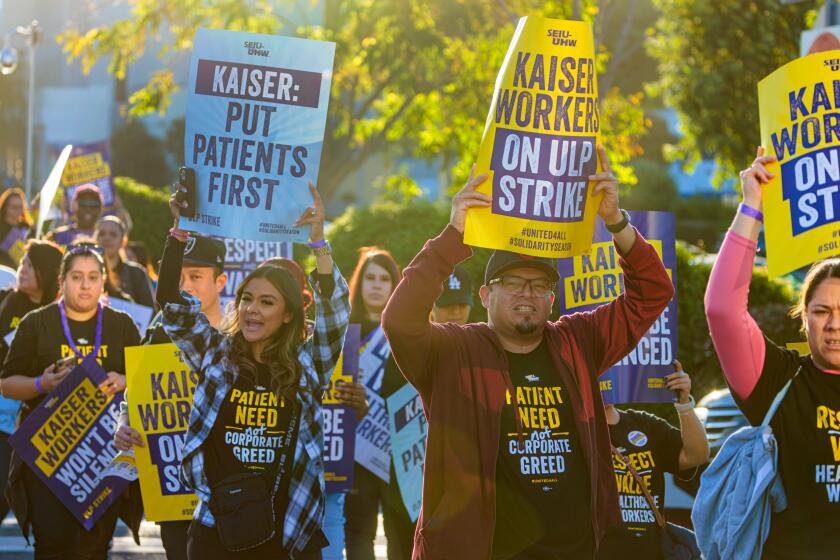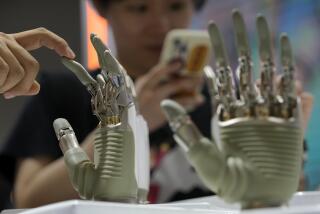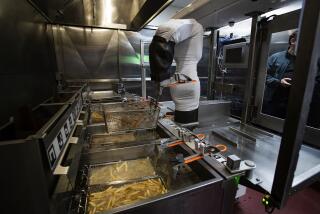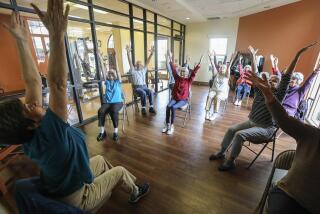Opinion: Elder care workers will always be essential. Will they always be underpaid? Send in the robots
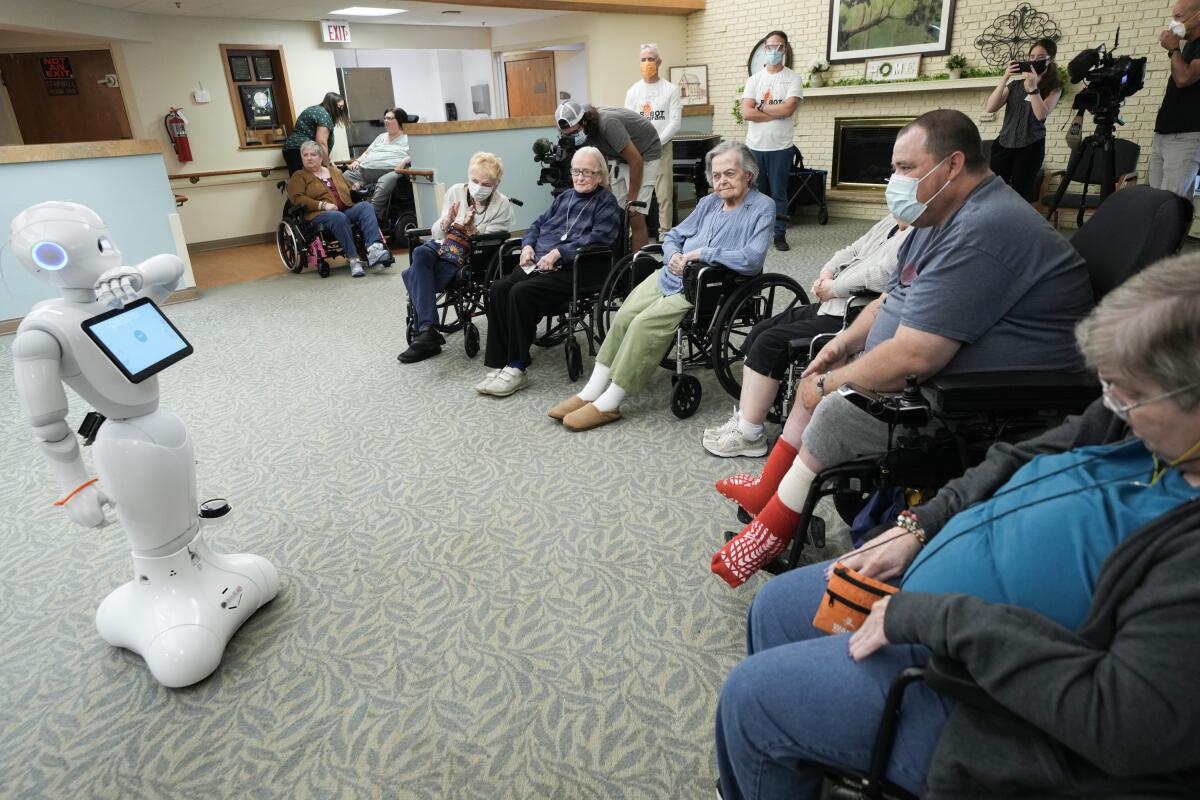
Few workers draw more sympathy and appreciation than the caregivers who tend to the daily needs of elderly people unable to cope by themselves. Working in homes or institutions, they help them eat, dress and bathe. The job is physically strenuous, emotionally demanding and essential to an aging population. But the pay is low — a median hourly $17.19 for nursing assistants.
Not surprisingly, the turnover rate is high. In 2023, more than 50% of certified nursing assistants in nursing homes left their jobs.
The California-based company’s difficulties are increasingly common in a sector battered by COVID, political polarization and other challenges.
The obvious solution is to increase wages. Aside from the turnover problem, paying so little for such important work strikes many people as wrong. But the problem isn’t indifference to the welfare of caregivers. As California recently learned, raising wages isn’t that easy.
In October, Gov. Gavin Newsom signed a law increasing the minimum wage for healthcare workers to $25 an hour. Last month, he asked to delay the increase. Facing a $38-billion budget deficit, the state can’t afford the bill. The state’s Finance Department estimates that the pay hike would cost $4 billion in the 2024-25 fiscal year, largely because of higher payments by Medi-Cal, the Medicaid program for low-income residents.
Pandemic-driven automation and remote work are likely to displace workers on a much larger scale than economists had expected.
Demanding higher wages doesn’t address the underlying problem: the brutal arithmetic of this labor-intensive work. Suppose you want to hire aides to take care of your elderly mother in her home. There are 8,760 hours in a normal year (although this leap year has 8,784). At $20 an hour, that’s $175,200. Few can afford such outlays.
Group facilities reduce the cost per patient by having a single aide responsible for multiple residents. But these efficiencies don’t go far. The higher the patient-to-staff ratio, the spottier the care.
The math doesn’t care about our feelings. The cold truth is that taking care of people who can’t take care of themselves is a low-productivity occupation. Unless wages are low, it quickly becomes unaffordable.
Physicians’ salaries account for a small fraction of U.S. healthcare costs; furthermore, doctors in this country often graduate deeply in debt.
Allowing large-scale legal immigration of people to do this work cheaply might alleviate the shortage, but in the current political environment the idea is a nonstarter. An unlikely historical analogy suggests that the way out of this dilemma most likely lies in radical technological innovation.
On the eve of the Industrial Revolution, the British textile industry had a similar problem. Every weaver required 20 to 30 spinners to supply enough yarn to keep the loom turning out cloth. Supply couldn’t keep up with demand. “The spinners never stand still for want of work; they always have it if they please; but weavers sometimes are idle for want of yarn,” wrote the agriculturalist Arthur Young, documenting his 1767 tour through the north of England.
For such an essential job, spinners’ wages were paradoxically low. In the Manchester area, Young reported, cotton spinners could earn two to five shillings a week, while weavers made three to 10. “Despite her essential role in England’s economic fate, the spinster received penurious wages for her work,” writes historian Deborah Valenze in “The First Industrial Woman.”
Like the low wages of today’s caregivers, however, spinners’ low wages weren’t the result of malice. Producing useful amounts of yarn simply took too long. Weaving went much faster and thus paid more per hour. But for textile merchants, spinning wasn’t cheap, even at “penurious wages.” The yarn in a given bolt of cloth cost twice as much as the weaving. Significantly raising spinners’ wages would have made cloth prohibitively expensive for most people.
The spinning machines that set off the Industrial Revolution broke the bottleneck. Yarn became as plentiful as it had once been scarce. Cloth became cheaper and more abundant, not only for clothes and household textiles but also for sails, sacks and other commercial essentials.
Technology allowed mills to change the way spinning was organized so that fewer workers were needed — but they were more productive and could therefore earn higher wages. A factory “spinner” no longer cleaned, carded or otherwise prepared the fiber. She simply loaded bobbins of prepared fiber and unloaded bobbins of spun yarn, earning five to seven shillings a week.
The early mills marked the beginning of the long economic takeoff that Deirdre McCloskey terms “the Great Enrichment.” Over the succeeding 250 years, stuff of all sorts has gotten progressively cheaper even as real incomes have risen to previously unimaginable levels. Complementing human labor with machines has made us extraordinarily productive — and we see the beginnings of this in healthcare settings already, with innovations such as continuous blood-pressure monitors.
But human attention is still scarce. And attention is what caregiving requires. The question, then, is what complementary technologies might amplify attention better than the TV screens now used to keep immobile old people ostensibly occupied.
Artificial intelligence, fed by sensors and embedded in robots, looks promising. Tiny wearable sensors or smart bedsheets could monitor vulnerable people for falls and health indicators, allowing many individuals greater independence. Intelligent programs could act as personal assistants, paying bills, scheduling doctor’s appointments, tracking medications and navigating bureaucracies. They would be speedier and have access to greater knowledge than the adult children who often handle such tasks today.
If robots can avoid being spooky, intimidating or patronizing, they could even be enjoyable, capable and patient companions — at least for those who want them. The trick is to create technology that can adapt to the individual. Some people might want to chat or play games with a robot. Others instead embrace the impersonal nature of a machine helper as a useful intelligent appliance rather than a buddy. A robot caregiver could allow the frail elderly to preserve their sense of privacy and personal space. Having a machine help you change clothes or use the toilet is less intrusive than hiring a stranger to do the same thing.
We are only beginning to see the possibilities. Like spinning, caregiving is bound to change radically as it incorporates new technologies. But people will still crave the human touch. By extending the abilities of human caregivers, such technologies could raise their productivity — making this widely respected calling better paid as well.
Virginia Postrel is the author of “The Fabric of Civilization: How Textiles Made the World” and a contributing editor for Works in Progress magazine. She writes a newsletter on Substack.
More to Read
A cure for the common opinion
Get thought-provoking perspectives with our weekly newsletter.
You may occasionally receive promotional content from the Los Angeles Times.
